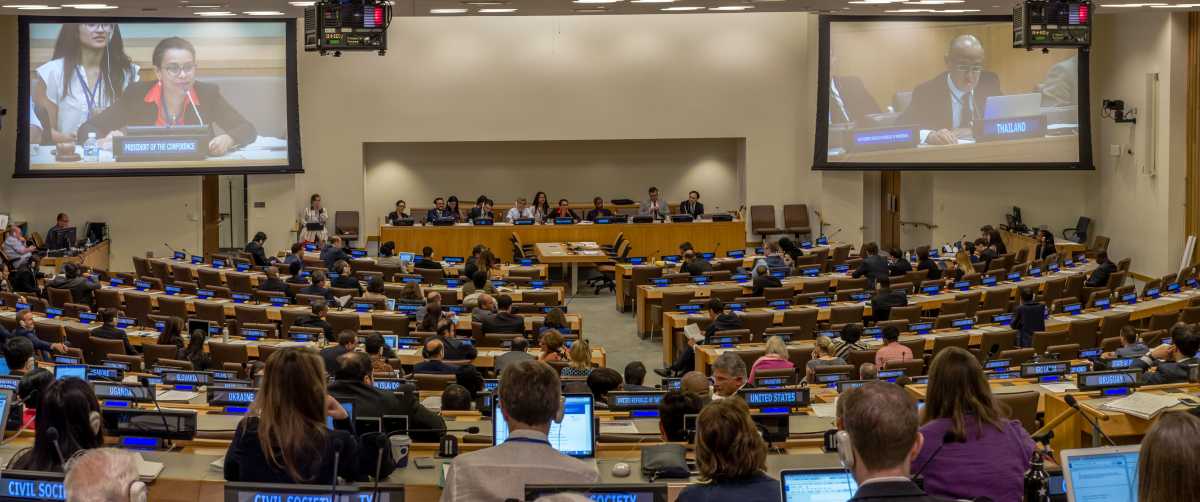Statement by Daryl G. Kimball, executive director
For Immediate Release: July 7, 2017
Media Contacts: Daryl G. Kimball, executive director, (202) 463-8270 ext. 107; Kingston Reif, director for disarmament policy, (202) 463-8270 ext. 104; Alicia Sanders-Zakre, research assistant, (202) 463-8270 x113
(United Nations, New York)—Today at United Nations headquarters, more than 130 states concluded negotiations on and adopted a new “legally-binding instrument to prohibit nuclear weapons.”
 The new Treaty on the Prohibition of Nuclear Weapons marks a new phase in the seven-decade-long effort to prevent nuclear war. For the first time since the invention of the Bomb, nuclear weapons development, production, possession, use, threat of use, and“stationing” of another country’s nuclear weapons on a states party's national territory are all expressly prohibited in a global treaty. The treaty also requires states to provide assistance to those affected by nuclear weapons use and testing.
The new Treaty on the Prohibition of Nuclear Weapons marks a new phase in the seven-decade-long effort to prevent nuclear war. For the first time since the invention of the Bomb, nuclear weapons development, production, possession, use, threat of use, and“stationing” of another country’s nuclear weapons on a states party's national territory are all expressly prohibited in a global treaty. The treaty also requires states to provide assistance to those affected by nuclear weapons use and testing.
While the treaty itself will not immediately eliminate any nuclear weapons, the treaty can, over time, further delegitimize nuclear weapons and strengthen the legal and political norm against their use. Steps aimed at reducing the risk of catastrophic nuclear weapons use are necessary and should be welcomed.
The new Treaty on the Prohibition of Nuclear Weapons aims to reinforce the key disarmament component (Article VI) of the 1968 Nuclear Non-Proliferation Treaty (NPT), which requires its 190+ states parties to “pursue negotiations in good faith on effective measures relating to cessation of the nuclear arms race at an early date and to nuclear disarmament.
Under the new treaty, states may not“test” nuclear weapons or any other nuclear explosive devices. This simply reinforces the 1996 Comprehensive Nuclear Test Ban Treaty (CTBT) which prohibits“any nuclear weapon test explosion or any other nuclear explosion” and has been signed by 183 states, including the United States, Russia, the United Kingdom, France, and China.
The new treaty, which was negotiated by a group of some 130 non-nuclear weapon states, is an expression of the deep concern about the enormous risks posed by nuclear weapons and the growing frustration with the failure of the nuclear-armed states to fulfill their nuclear disarmament commitments. The initiative underscores the need for thenuclear weapons states’ to meet their existing legal obligations to end the nuclear arms race and pursue disarmament and the catastrophic humanitarian consequences of nuclear weapons.
In our view, and in the view of many delegations, the final text of the Nuclear Weapons Prohibition Treaty should have been stronger. Key areas, particularly Article 3, which outlines the requirements for safeguards against nuclear weapons programs, could have been strengthened and improved.
While the new treaty usefully outlines key objectives for verifying disarmament by nuclear-armed states in the future, the new treaty only obligatesstates parties not possessing nuclear weapons to maintain or bring into force a Comprehensive Safeguards Agreement with the IAEA“at a minimum."
Unfortunately, the new Treaty on the Prohibition of Nuclear Weapons makes no specific reference to the value of more rigorous inspection procedures, known as the Additional Protocol or “AP+” measures, which is a goalthat states parties at this conference have already agreed to pursue in the context of the NPT. The 2000, 2010, and 2015 NPT Review Conference reports all stressed “that comprehensive safeguards and additional protocols should be universally applied once the complete elimination of nuclear weapons has been achieved.”The history of the Iraqi, North Korean, and Iranian nuclear programs shows that the IAEA safeguards regime must and has and will continue to evolve in order to effectively guard against clandestine nuclear weapons programs.
The new Treaty on the Prohibition of Nuclear Weapons is a historic step forward but, clearly, it is not an all-in-one solution to the dangers posed by nuclear weapons. Additional and difficult work lies ahead.
Prohibition treaty supporters, skeptics, and opponents must put aside their disagreements about the new agreement and find new and creative ways to come together to strengthen the nuclear disarmament and nonproliferation regime.
They must focus on advancing new and effective disarmament measures, while pursuing policies that ease the growing tensions between nuclear-armed states and increase the danger of nuclear weapons use.
Such measures include but are not limited to:
- securing the remaining eight ratifications, including the United States, China, Iran and Israel, needed to bring the CTBT into force;
- reviving the moribund U.S.-Russian arms control and risk reduction dialogue, including resolving U.S.-Russian treaty compliance disputes and extending the New START agreement beyond 2021;
- bringing China, India, and Pakistan further into the nuclear risk reduction and disarmament process;
- avoiding the introduction of new and destabilizing nuclear weapons systems and capabilities;
- concluding an agreement on legally-binding negative nuclear security assurances for nonnuclear-weapon states;
- continuing to implement and build upon the agreement between Iran and six world powers that verifiably limits its weapons-relevant nuclear activities; and
- engaging in pragmatic and sustained diplomacy with North Korea, coupled with smart sanctions, to halt and reverse that country’sdangerous nuclear pursuits.
Nuclear weapons pose a global threat that demands global cooperation. Now is the time for stronger and smarter leadership from Washington, Moscow, and Beijing, as well as more active support from the world’s non-nuclear weapon states.
###
The Arms Control Association is an independent, membership-based organization dedicated to providing authoritative information and practical policy solutions to address the threats posed by the world's most dangerous weapons.
